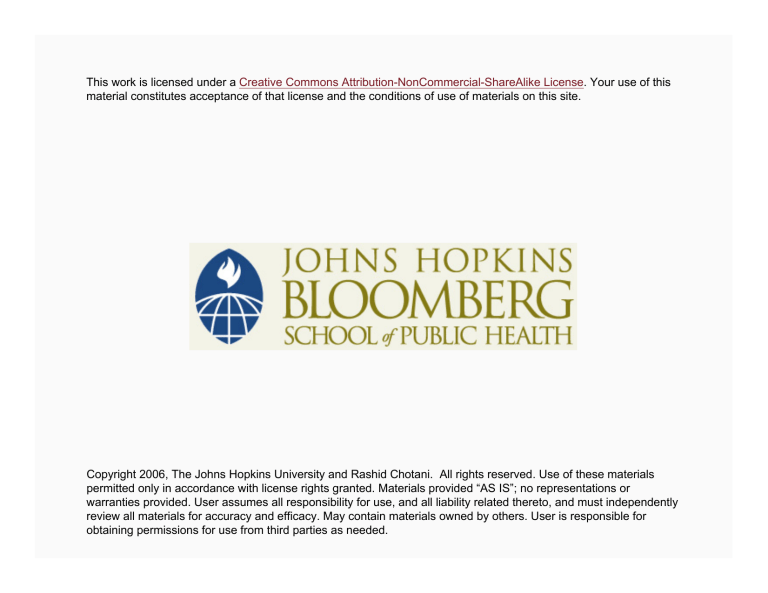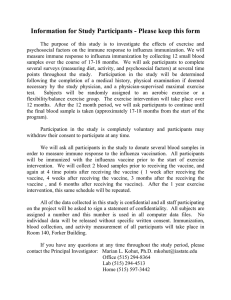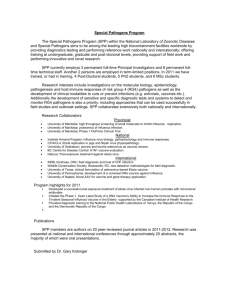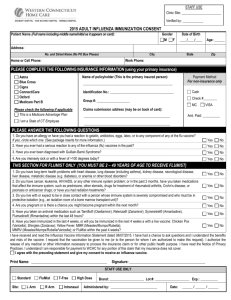licensed under a . Your use of this Creative Commons Attribution-NonCommercial-ShareAlike License

This work is licensed under a Creative Commons Attribution-NonCommercial-ShareAlike License . Your use of this material constitutes acceptance of that license and the conditions of use of materials on this site.
Copyright 2006, The Johns Hopkins University and Rashid Chotani. All rights reserved. Use of these materials permitted only in accordance with license rights granted. Materials provided “AS IS”; no representations or warranties provided. User assumes all responsibility for use, and all liability related thereto, and must independently review all materials for accuracy and efficacy. May contain materials owned by others. User is responsible for obtaining permissions for use from third parties as needed.
The Impact of Pandemic Influenza on Public Health
Rashid A. Chotani, MD, MPH
Director, Global Infectious Disease Surveillance and Alert System
Johns Hopkins University
Part Five of Six
Interventions
WHO Global Influenza Surveillance Network
Recommendations on Influenza Vaccine Formulation
Source: WHO Global Influenza Program 4
Influenza Vaccine Development
Source: WHO Global Influenza Program 5
Vaccine Production
Lag between pandemic strain detection and full scale vaccine production
Source: WHO Global Influenza Program 6
Key “Bottlenecks”
1.
“Purity” of strain
2.
Production requirements
−
Production system “EGG”
−
Bio-security
3.
Clinical data allowing increase in vaccine availability
Reverse genetics
Source: WHO Global Influenza Program 7
Vaccine Production Capacity
Source: WHO Global Influenza Program 8
Vaccine Consumption, 2000
Source: WHO Global Influenza Program 9
Vaccine
Challenges
−
H5HA is poorly immunogenic as compared to H3N2 or
H1N1 viruses
X To date vaccines against H5 have required two doses or an adjuvant to induce a necessary level of neutralizing antibodies
−
Influenza virus has a high error rate making it evolve continuously
−
There are already two clades of HPAI H5N1 virus circulating
−
Manufacturing capacity is limited and licensing requirements are stringent
10
Vaccine
September 16th, 2005—HHS
News headlines
−
U.S. DHHS [is] buying $100 million worth of avian vaccine
−
Vaccine has not been approved by FDA
−
Proper dosage [is] being determined
X Protection for two to twenty million Americans
11
Vaccine
Inactivated vaccine candidate:
−
Sanofi Pasture has developed an unadjuvanted, inactivated H5N1 vaccine candidate
−
Prospective, randomized, double-blind trials (~450 adults,
18-64 years) established the need for two doses
(neutralizing titer 1:40)
−
Now being tested in children and the elderly
Live, attenuated vaccine candidate:
−
MedImmune (under U.S. contract) will develop at least one vaccine for each of the 16 HA
−
Candidate vaccine has been developed for H5 and H9
(phase one clinical trials)
12
Vaccine
Sanofi Pasture has developed an unadjuvanted, inactivated
H5N1 (virus isolated in Southeast Asia in 2004) vaccine candidate
Reported in NEJM
−
The higher the dosage of vaccine, the greater the antibody response produced
−
Of the 99 people evaluated in the 90-mcg, high-dose group, 54 percent achieved a neutralizing antibody response to the vaccine at serum dilutions of 1:40 or greater
−
Only 22 percent of the 100 people evaluated who received the 15-mcg dose developed a similar response to the vaccine
13
Vaccine
Sanofi Pasture has developed an unadjuvanted, inactivated
H5N1 (virus isolated in Southeast Asia in 2004) vaccine candidate
Reported in NEJM
−
Generally, all dosages of the vaccine appeared to be well tolerated
−
Almost all reported side effects were mild
−
The second dose of the vaccine did not cause more local or systemic symptoms than the first
−
Systemic complaints of fever, malaise, muscle aches, headaches, and nausea occurred with the same frequency in all dosage groups as in the placebo group
−
Lab tests did not reveal any clinically significant abnormalities
14
Vaccine
A new genetically engineered vaccine, created by scientists at the CDC, is egg-independent and adjuvant-independent
−
Hoelscher, M.A., at al. (2006). Lancet . Feb 11; 367(9509):
475-81
A similar vaccine, adenovirus-based influenza A virus vaccine directed against the hemagglutinin (HA) protein of the
A/Vietnam/1203/2004 (H5N1) (VN/1203/04) strain isolated during the lethal human outbreak in Vietnam from 2003 to
2005
−
Gao, W., et al. (2006). Protection of mice and poultry from lethal H5N1 avian influenza virus through adenovirusbased immunization. J Virol . Feb; 80 (4): 1959-64
15
Chemotherapy
Prevent membrane fusion (M2 Inhibitors)
−
Amantidine (Symmetrel)
−
Remantidine (Flumadine)
Neuraminidase inhibitors
−
Zanamivir (Relenza)
X U.S. is buying $2.8 million (could treat 84,300 people)
−
Oseltamivir (Tamiflu)
−
Peramivir (more potent in vitro)?
16
Chemotherapy
Relenza
−
Reduced the incidence of the disease in both young and older populations
−
First study—in participants 18 years of age or older, the proportion of people who developed symptoms confirmed to be the flu was 6.1% for the placebo group and 2.0% for the Relenza group
−
The second community study—enrolled people 12 to 94 years of age (56% of whom were older than 65 years)
X In this trial, the percentage of people who developed symptoms confirmed to be the flu was reduced from
1.4% of the participants on placebo to 0.2% for those who used Relenza
17
Types of Protective Masks
Surgical masks
−
Easily available and commonly used for routine surgical and examination procedures
High-filtration respiratory mask
−
Special microstructure filter disc to flush out particles bigger than 0.3 micron
−
These masks are further classified:
X Oil proof
X Oil resistant
X Not resistant to oil
−
The more a mask is resistant to oil, the better it is
−
The masks have numbers beside them that indicate their filtration efficiency
−
For example, a N95 mask has 95% efficiency in filtering out particles greater than 0.3 micron under normal rate of respiration
18
Types of Protective Masks
The next generation of masks are called Nanomasks
These boast of the latest technologies like 2H filtration and nanotechnology, which are capable of blocking particles as small as 0.027 micron
19
Do N95 Respirators Provide 95% Protection?
AJIC paper by Balazy, et al.
Recent study in AJIC by Balazy, et al., looked at respiratory protection devices used to protect the wearers from inhaling particles suspended in the air
Filtering face piece respirators are usually tested utilizing non-biologic particles, whereas their use often aims at reducing exposure to biologic aerosols, including infectious agents such as viruses and bacteria
20
Do N95 Respirators Provide 95% Protection?
The investigators studied the performance of two types of
N95 half-mask, filtering face piece respirators and two types of surgical masks
The collection efficiency of these respiratory protection devices was investigated using MS2 virus (a non-harmful stimulant, of several pathogens)
The virions were detected in the particle size range of 10 to 80 nm
21
Do N95 Respirators Provide 95% Protection?
AJIC paper by Balazy, et al.
The results indicate that the penetration of virions through the National Institute for Occupational Safety and Health
(NIOSH)-certified N95 respirators can exceed an expected level of 5%
The tested surgical masks showed a much higher particle penetration because they are known to be less efficient than the N95 respirators
The two surgical masks, which originated from the same manufacturer, showed tremendously different penetration levels of the MS2 virions—20.5% and 84.5%, respectively, at an inhalation flow rate of 85 L/min
22
Do N95 Respirators Provide 95% Protection?
AJIC paper by Balazy, et al.
This study concluded that . . .
−
N95 filtering face piece respirators may not provide the expected protection level against small virions
−
Some surgical masks may let a significant fraction of airborne viruses penetrate through their filters, providing very low protection against aerosolized infectious agents in the size range of 10 to 80 nm.
−
It should be noted that the surgical masks are primarily designed to protect the environment from the wearer, whereas the respirators are supposed to protect the wearer from the environment ( Am J Infect Control 2006;
34: 51-7)
23
Capacity
There are six manufactures of N95 respirators in the U.S.
As of March 2006, the two largest U.S. manufacturers are at full capacity running 24/7
Both of these played a large roll in filling the U.S. government’s order for approximately 100,000,000, N95 masks
Lead time on certain styles is as long as five months
U.S. inventory of unsold N95s changes on an hourly basis
−
The inventory is also at a record low quantity
24
Capacity
Other shortages now surfacing for the first time are for the following:
−
Influenza field tests kits
−
Hand sanitizers
−
Protective coveralls
−
Booties
Pricing on N95 respirators with out escalation value is inching up
The market is clearly on a first come first serve basis
Smaller sizes have all but disappeared due to Asian demand
25
Food Safety
Conventional cooking (temperatures at or above 70°C in all parts of a food item) will inactivate the H5N1 virus
Properly cooked poultry meat is therefore safe to consume
The H5N1 virus, if present in poultry meat, is not killed by refrigeration or freezing
Home slaughtering and preparation of sick or dead poultry for food is hazardous—this practice must be stopped
Eggs can contain H5N1 virus both on the outside (shell) and the inside (whites and yolk)
Eggs from areas with H5N1 outbreaks in poultry should not be consumed raw or partially cooked (runny yolk); uncooked eggs should not be used in foods that will not be cooked, baked, or heat-treated in other ways
26
Food Safety
There is no epidemiological evidence to indicate that people have been infected with the H5N1 virus following consumption of properly cooked poultry or eggs
The greatest risk of exposure to the virus is through the handling and slaughter of live infected poultry
Good hygiene practices are essential during slaughter and post-slaughter handling to prevent exposure via raw poultry meat or cross contamination from poultry to other foods, food preparation surfaces, or equipment
27
Survival of Influenza Virus on Surfaces
The World Health Organization recommends that environmental surfaces be cleaned by the following:
−
Disinfectants such as sodium hypochloride, 1% in-use dilution, 5% solution to be diluted 1:5 in clean water, for materials contaminated with blood and body fluids
−
Bleaching powder seven grams per liter with 70% available chlorine for toilets and bathrooms
−
70% alcohol for smooth surfaces, tabletops, and other surfaces where bleach cannot be used
−
Environmental cleaning must be done on a daily basis
28
New Laboratory Test
The FDA has approved a new laboratory test developed by the CDC to diagnose H5 strains of influenza in patients suspected to be infected with the virus
The product—the Influenza A/H5 (Asian lineage) Virus Real-time
RT-PCR Primer and Probe Set provides preliminary results on suspected H5 influenza samples within four hours once a sample is tested
If the presence of the H5 strain is identified, then further testing is conducted to identify the subtype
If clinicians suspect a patient may be infected with an avian influenza virus, they should contact their state or local health department
For more information:
−
CDC (2006). New laboratory assay for diagnostic testing of avian influenza A/H5 (Asian lineage). MMWR , 55 (RR5): 127
29






